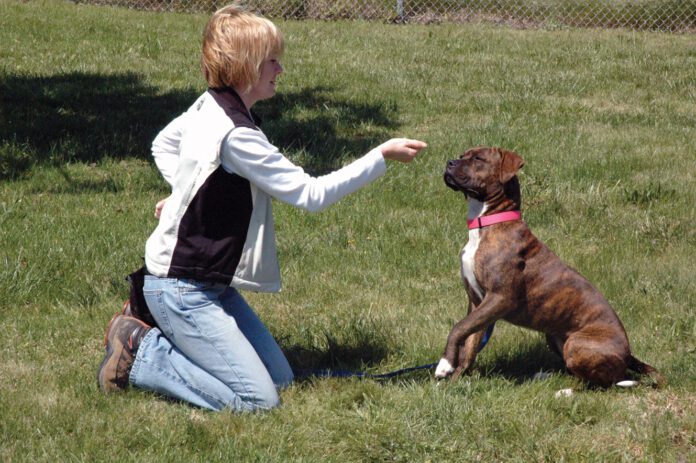Listen to a mom tell her child to “Behave!” You know what she really means is “Stop doing that annoying behavior!” Similarly, for a long time in the dog-training world a dog who “behaved” was seen as one who didn’t do much; he just sat or lay quietly around the house.
Today, thanks to the shift toward positive-reinforcement-based training and a better understanding of the science of behavior and learning, dog trainers and owners are coming to understand the value of dogs who offer behaviors. “Behave” is actually an action word.
There are several different ways to get your dog to do lots of stuff. You can lure, shape, capture, use imitation, and, yes, you can even coerce and physically manipulate your dog into performing certain behaviors. Coercion was the mainstay of old-fashioned training, and carries with it a high likelihood of unwanted side effects, including fear, aggression, and learned helplessness (shutting down).
Today’s educated, competent, modern, positive-based trainers strenuously avoid the use of coercion and manipulation, relying instead on the first four techniques in order to get their dogs to happily and willingly offer behaviors during the training process.
Keep in mind that getting the dog to do something is just the beginning of that process. In order to “train” a behavior, you start by getting it to happen; once you are able to get your dog to perform a certain behavior (using any of the methods described in this article) you reward and thus reinforce it, so as to increase its frequency. The next step is to associate the behavior with a cue, which will replace whatever you originally did to get the behavior. This is an important step; many amateur trainers fail to ever “fade” (eliminate) whatever method they used to originally get the dog to perform the behavior, and the dog never manages to figure out the cue.
The goal is to get the dog to quickly realize and reliably understand that the cue – not the luring or shaping, etc. – indicates that he has an immediate opportunity to earn a reward for performing a specific behavior. (Act now! Limited time offer!)
“Luring” Your Dog
“Luring” involves the use of a desirable object, often food, to entice your dog into doing the behavior you want. To lure a dog to sit, put a treat at the end of his nose and raise the treat up and back over his head (not too high, he’ll jump up instead of sitting!). To lure a sitting dog into a stand, put the treat in front of his nose and move it away from him, parallel to the ground. To lure him into your car, take his favorite toy, get in the car yourself, and show him the toy. Squeak it, bounce it, and/or toss it in the air to increase its value.
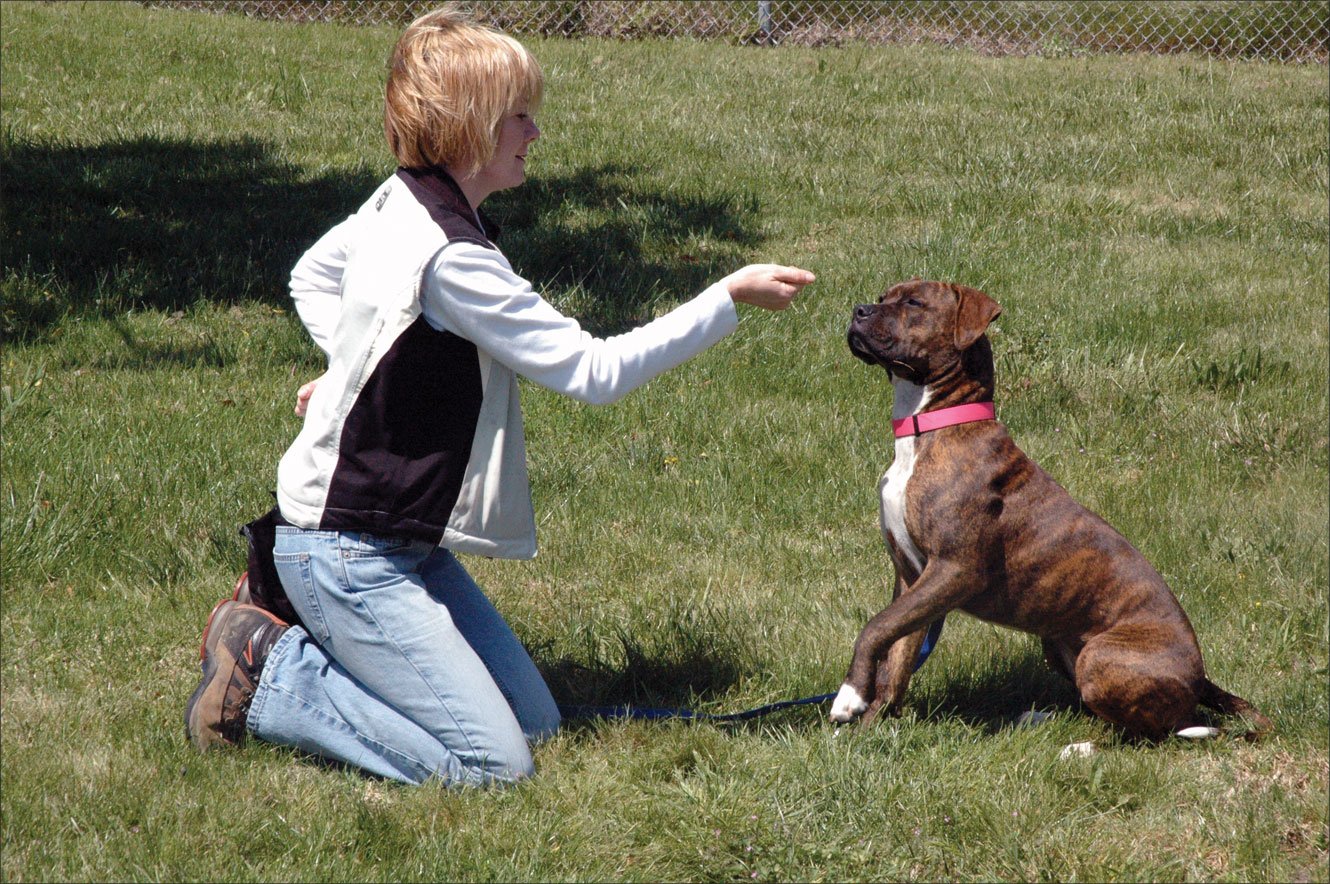
You can also lure-shape, which means luring and reinforcing pieces of the behavior until the dog can do the complete behavior. Since many dogs won’t lure all the way down to the ground on the first try, we often use lure-shaping to get a dog to lie down. While luring is frowned upon by some trainers, especially by shaping “purists,” it can be an effective way to get a behavior relatively quickly.
Disadvantages of Luring Dogs
Dog and human can become dependent on the presence of the lure to get the behavior. The dog may learn to wait until the lure is offered to do the behavior. The human may believe her dogs won’t be able to do the behavior without the lure. You must “fade” the lure quickly in order to avoid lure-dependence.
Some humans are not skilled at fading the lure.
Luring can be seen as a form of coercion – when the dog doesn’t really want to do the behavior, but because he wants the treat so badly he feels compelled to do it. There may be fallout in the form of increased stress for the dog, or worse.
Example: The dog is fearful of strangers, but his owner has given a stranger a high-value treat and asked him to offer it to the dog. The dog doesn’t want to approach the stranger, but he really wants the treat, so he does. He accepts and eats the treat and then, realizing he is way too close to the scary stranger, bites.
We use luring a lot in the Basic Good Manners classes at Peaceable Paws (my training center in Fairplay, Maryland). Novice dog owners tend not to have the patience or the understanding, at least a first, for the complexities of techniques like shaping. I may also use luring with a novice dog who hasn’t been introduced to shaping, if I need to get a behavior quickly for some reason, and don’t have time to teach him the concept of shaping or imitation.
“Shaping” Your Dog
“Shaping” is the process of breaking a behavior into small steps, reinforcing the dog many times at each step before moving to the next, until, through successively more accurate approximations, you build the entire behavior.
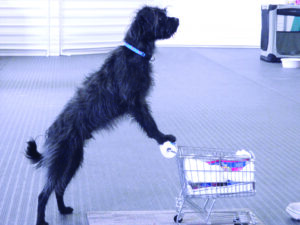
To shape a dog to pick up an object, for example, you might first click and treat him for glancing at it. When you see that he deliberately looks at it in order to make you click and treat, you could click/treat him for looking at it while moving his head very slightly toward it. It might take several steps (numerous repetitions and reinforcements at each step) until he is at the “sniff the object” step. The next step might be to touch the object with his nose, then open his mouth slightly, and so on, until he is picking up the object.
Shaping is a fantastic way to develop a dog who is quick and eager to offer behavior. This makes training new, sometimes amazingly complex behaviors, happen much more easily and quickly than does luring. In fact, there are some complex behaviors you’d be hard-pressed to figure out how to lure that might be relatively simple to shape.
There are actually three versions of shaping:
Pure Shaping. You have a goal behavior in mind, you create a shaping plan, and work as described above until you have the full behavior.
Lure Shaping. As described in the Luring section above, you use a combination of luring and shaping to get the behavior you want.
Free Shaping.Also known as “101 Things to do With a Prop,” free shaping is an exercise intended to encourage your dog to offer lots of different behaviors – a very useful skill down the road when you are working to shape complex or particularly creative behaviors; some of the most amusing tricks come out of this exercise. (See “101 Things to do With a Prop.”) It’s important when doing free shaping to studiously avoid having a behavior goal in the back of your mind, but rather to celebrate (and reinforce) a variety of behaviors.
Disadvantages of Shaping a Dog
Shaping requires patience, good observational skills, and good timing. It can be frustrating for a novice trainer to shape behaviors.
Novice shapers tend to “lump” (look for and reinforce big pieces of behavior) rather than “split” (look for and reinforce very small pieces of behavior).
It can be frustrating – and boring – for the dog as well as the human, if the handler isn’t skilled at shaping. If the handler is “lumping,” the dog doesn’t get reinforced enough to keep him playing the game. If the handler’s timing is bad, the dog can’t figure out what on earth he is getting clicked for, and the shaping moves forward very slowly, if at all.
I use shaping almost exclusively now with my own dogs because, once they understand the concept you can teach new behaviors very quickly. At my training center, we also use it in the advanced classes, where students have demonstrated their commitment to and interest in a greater understanding of behavior and learning.
“Capturing” a Behavior
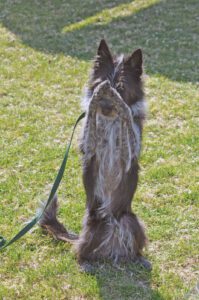
“Capturing” is so easy it almost seems like cheating. You just need to have your reward marker handy (hence the value of teaching your dog a verbal marker as well as a clicker), and easy access to treats or some other high-value reinforcer. Anytime your dog just happens to do something you like, mark it and give him a treat. In time, your dog will start to offer the behavior in order to make you click.
Capuring is easiest to do with behaviors that are somewhat predictable. Does your dog always stretch when he comes out of his crate? Be ready to click the instant he does it. This can be a terrific way to train behaviors that your dog offers spontaneously and that are challenging to lure or shape.
Disadvantages of Capturing a Behavior
You can capture only behaviors that your dog offers.
You have to be quick, with excellent timing to capture spontaneous behaviors with enough frequency that your dog gets it and starts offering the behavior. (Note: Dogs who are clicker-savvy and who have done a lot of shaping are likely to catch on most quickly.)
I use capturing (with a verbal marker) as described above when one of my dogs offers a spontaneous behavior that I want to encourage – especially one that might be difficult to shape or lure. (It’s usually something cute.)
Teaching Your Dog to Imitate You
A spanking-new concept for the dog-training world, “imitation” involves teaching your dog a cue that means “Copy what I just did.” While not yet a mainstream technique, it shows a lot of promise, especially for shortcutting the training of complex behaviors. Once your dog has learned the imitation concept, you simply have him sit and watch while you demonstrate the behavior, return to him and give him your “Copy” cue. Then he does the behavior.
Imagine for a moment the painstaking process of teaching your dog to run weave poles for agility. Now imagine that all you need to do is have your dog watch you while you run the weave poles, return to him, tell him “Copy!” and sit back and watch him run the poles, letter-perfect. Okay, maybe it’s not quite that easy, but still . . . a lot of service-dog skills and a whole host of other behaviors could lend themselves quite well to imitation.
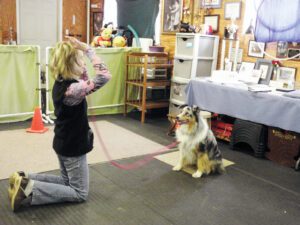
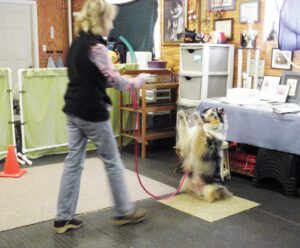
Disadvantages to Imitation
It requires an investment of time in the training process to teach your dog the imitation concept.
You cannot use imitation for behaviors that your dog does with you or to you because you cannot demonstrate them. How would you demonstrate heeling? Or weaving between your own legs?
You cannot use imitation for behaviors that are beyond human capability. Some humans can do a back flip, for example, but I would be unable to demonstrate that behavior for my dog.
While I have taught our dog Bonnie the imitation concept, I admit that I haven’t taken it further to teach her new behaviors. I am working with a group of four students in their sixth week of class, and their dogs are just reaching the point where they may be ready to try learning new behaviors using imitation. Stay tuned for updates!
As you can see, there are many different ways to get your dog to “behave” by developing happy and willing participation in the training process and encouraging your dog to offer behaviors. There is no “right” way; you have many choices, depending on your dog, goals, and training skills. If you’re stumped by shaping, or eager to try imitation, find a qualified positive-training professional who can help you add those new techniques to your repertoire. Now – if you want your dog to “behave” – go teach him to do lots of stuff!
“Click and treat” – This term is used by many trainers who use positive reinforcement as a major tool in their training toolbox – even if they don’t actually use a clicker!
To “click” is to use a consistent signal – often, but not always the “click” of a clicker – to let the dog know that the thing he just did just earned him a reward. In order to be effective, this signal needs to be sharp and discrete, as it’s being used to “mark” the desired behavior as cleanly as possible. Clickers make a distinctive and highly consistent sound, which is more effective than a sound that changes each time in pitch and tone, but most dogs are capable of understanding and lumping together similar-sounding or similar-looking signals.
Audible signals (such as a click or a spoken word, such as “Yes!”) are the easiest for many handlers to use, but visible signals are needed for deaf dogs (or senior dogs who are on their way to deafness). Many trainers of deaf dogs use the flash of a small flashlight or a thumbs-up gesture as their marker signal.
In almost every article we present about training, we use the word “click” to indicate the use of a marker signal, but you can mentally replace it with whatever marker you prefer.
As to the “treat” – The click or other marker is followed, every time, as immediately as possible, with a reward. Most dogs like food, and are willing to work for bits of high-value, super-yummy food, like chicken, roast beef, hot dogs, cheese, etc. But some dogs are more highly motivated by toys, and still others by praise and petting. Make sure, however, that whatever you use as a “reward” is truly rewarding for your dog. If you pet him, and he moves away – that’s not a reward, that’s a punishment. His response tells you he does not like it and does not want more of it. Use whatever rewards rivet your dog’s attention on you.
Often, trainers start a session by “charging” the clicker, by clicking it no matter what the dog is doing, and giving him a treat after each click. You generally have the dog’s rapt attention after four or six clicks and treats! That’s all most dogs need to undersand the concept: when he hears a click (or experiences another consistent marker signal), he’s going to get a treat. It’s also usually enough to elicit most dogs’ interest in doing things – offering behavior – in order to get more of those clicks and treats.
101 Things to Do With a Prop
This exercise started out as “101 Things to do With a Box“. Then trainers realized it doesn’t have to be a box, you can play “101 Things to Do” with any prop – a traffic cone, a stool, a metal pan, a child’s wagon, or… ? The goal is to encourage your dog to offer behaviors until he has a large repertoire. Then, in the future, when you are trying to shape a specific behavior, he will give you lots of behaviors to choose from.
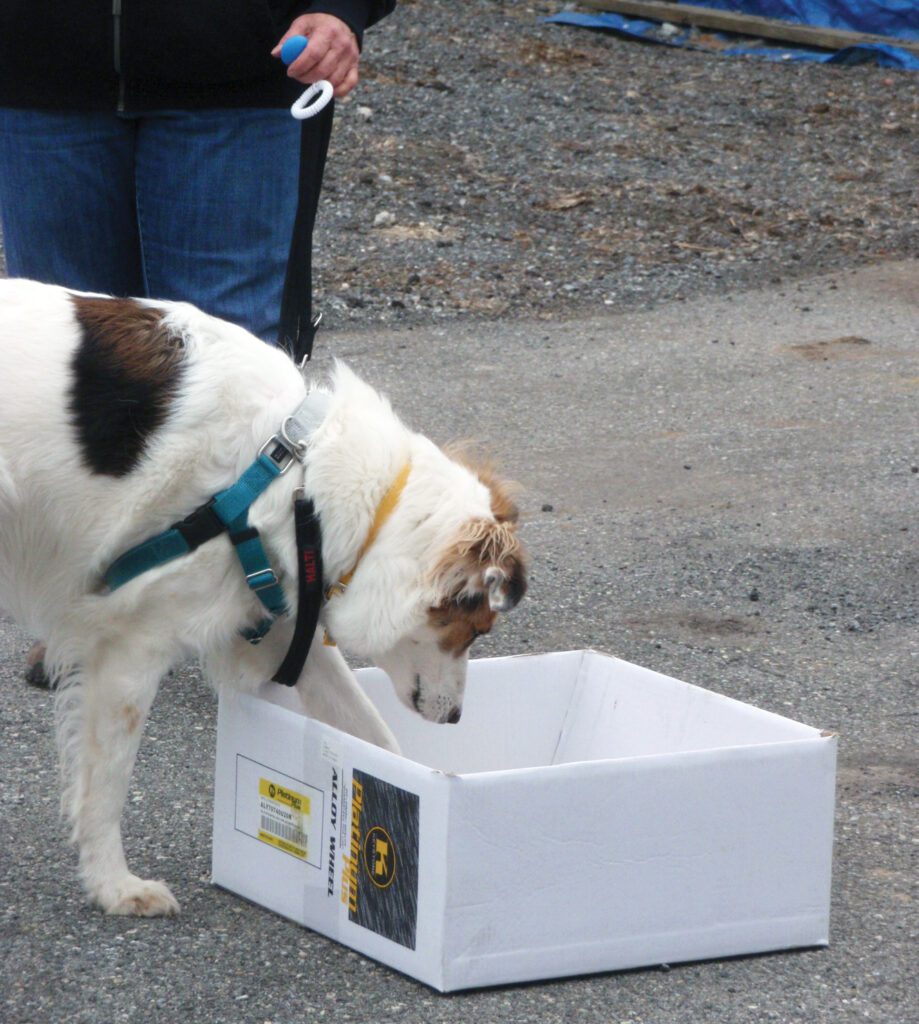
Your dog can be on leash or off (if he’ll stay with you). Set a chair a few feet back from the box or object, sit in the chair, and wait. (I use a “Do it!” cue to let my dog know the game is on.) If your dog glances toward the box, leans toward it, steps toward it – anything – click and feed him a treat. Look for tiny pieces of behavior to click and treat – any behavior that relates to the prop – a look, a step, a sniff, a push . . . .
You have no specific goal in mind, and you don’t have to build up to a behavior – in fact you shouldn’t; random behaviors are desirable. If your dog seems hung up on one particular behavior, stop clicking that one and wait for something else. I use a “Try something else!” cue to let my dogs know I’m not going to click that particular behavior any more.
The more confidently your dog offers behaviors, the more easily you can quit click/treating one thing and wait for another. At some point, if you wish, you can decide on a goal behavior for that prop based on the ones your dog has offered, and shape it into something specific. Don’t be in a hurry to do this unless your dog is already skilled at the 101 Things game!
How to Fade Using the Lure
One of the criticisms of lure-training is that dog and human become dependent on the lure to get the behavior; if the dog doesn’t see the treat in your hand, he doesn’t perform. It is a valid and unfortunate criticism – unfortunate because it is really pretty easy to fade the lure from your training.
The moment you can lure the behavior easily, it’s time to fade the lure. With your treat-hand behind your back, cue the behavior. If your dog does what you asked for, click and treat. If he doesn’t, bring the treat out and lure (or prompt) the behavior as you normally would. Click and treat. Gradually (and variably) increase the length of time you wait after giving the verbal cue before you use the lure or prompt. You must give your dog’s brain time to process the information and to send the cue message through the nervous system to his muscles. Watching this thought process is one of the great joys of positive training! Be patient. As long as it looks like he’s trying to figure it out, wait. If he gets distracted or loses interest, try again.
If he still doesn’t perform the behavior, fade the lure or prompt more gradually. Cue the behavior, pause, and if your dog doesn’t do the behavior, do a partial lure.
For example, if you are working on “down,” say “Down,” wait several seconds, and then bring out your lure and being to move it toward the floor. When your dog begins to go down, instead of moving the treat all the way to the floor, whisk it parallel to the ground (so you don’t inadvertently lure him upward) and quickly behind your back, and let him finish the down on his own. Gradually lure less and less, until he’s lying down on cue without any luring.
Note: I am not a fan of prompting with a “pretend” cookie in your hand. You may have faded the actual treat lure, but you have added in an extra step, and deceived your dog in the process. Now he may not believe you when you do have a treat in your hand, and you still have to fade the empty hand prompt.


